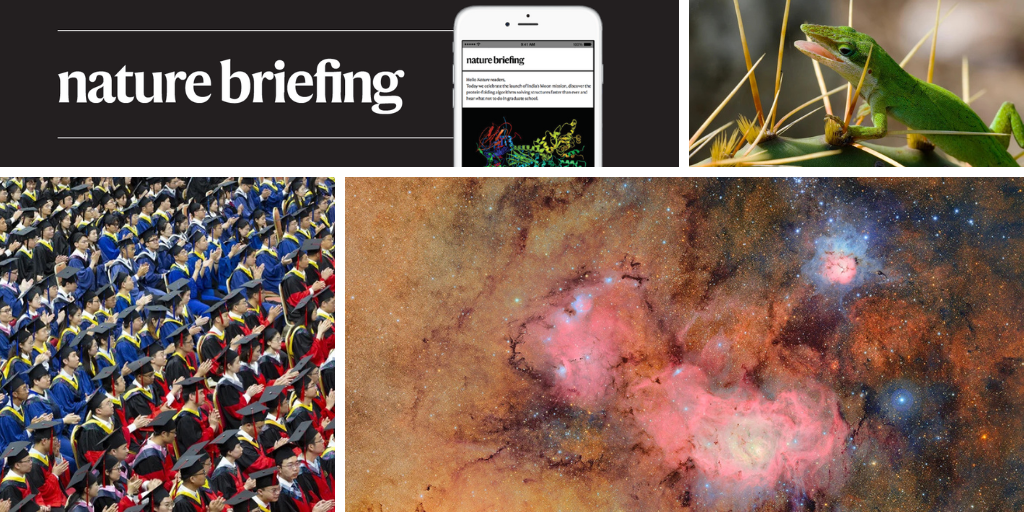You have full access to this article via your institution.
Hello Nature readers, would you like to get this Briefing in your inbox free every day? Sign up here.

The Trifid Nebula (top right) and the Lagoon Nebula, in an image made from 678 separate exposures taken at the Vera C. Rubin Observatory in Chile.Credit: NSF-DOE Vera C. Rubin Observatory
The Vera C. Rubin Observatory in Chile has unveiled the first images taken using its 3,200 megapixel digital camera — the largest in the world. The images were put together mainly for aesthetic impact and to showcase the camera’s prowess, so they’re quite different to the ‘data products’ astronomers use for research, says the observatory’s Sandrine Thomas. Instead, they’re a reminder of what drives astronomers in the first place. “We go into astronomy because we like to look at the sky — and at the beauty of it,” she says.
A study including data from more than 100,000 grant applications has revealed some of the underlying causes of the ‘Matthew effect’ — a phenomenon describing how scientists that secure funding grants early in their career are more likely to do so again later. Mathematical modelling of data from funding programmes in four countries suggested that those who had early grant success applied more often for future grants than those who didn’t, which explained the difference between the two groups. A new model of funding that rewards “promising but previously unsuccessful applicants” could level the playing field, says social scientist and study co-author Vincent Traag.
Reference: Figshare preprint (not peer reviewed)
Axolotls can rebuild entire limbs and brain parts, zebrafish can mend broken spinal cords and green anole lizards can fabricate new tails. Scientists are taking what they have learnt about the regenerative powers of these and other animals and applying that knowledge to human cells, thanks to advances in genomics, proteomics and imaging at the level of the single cell. “I would love to see this go all the way to therapy,” says Mayssa Mokalled, who studies tissue regeneration and stem-cell biology.
“The numbers are massive, and they keep growing,” says higher-education researcher Hugo Horta, speaking of the surge in doctoral students in China. Students enrolled in PhD programmes there have doubled in recent years, from around 300,000 in 2013 to more than 600,000 in 2023 — but the number of jobs in academia has not kept pace. For PhD holders in the United States, Australia and the United Kingdom, non-academic jobs are also increasingly becoming the norm. But that’s not necessarily bad news: a 2023 study of PhD graduates in the UK found that more than 90% were happy with their career.
Features & opinion
Machine-learning systems that predict patient outcomes are only as good as the data the systems are trained on. If they are deployed carelessly, their very successes can contaminate the data, argues health-AI researcher Akhil Vaid. For example, if a machine catches early signs of sepsis and doctors treat it, “this creates a ‘contaminated association’ in the data, in which warning signs of sepsis seem to lead to good outcomes”, writes Vaid. One solution is to preserve ‘clean data’ at institutions where predictive models are not used. But this raises serious ethical questions, because it involves withholding potentially beneficial AI tools from some patients.
A new kind of drug to prevent HIV has been approved by the US Food and Drug Administration: lenacapavir, which disrupts the proteins that form the virus’s capsid shell. Unlike existing pre-exposure prophylaxis (PrEP) regimens, which involve taking a daily pill, lenacapavir need only be injected every six months. Last July, attendees at the 2024 AIDS Conference in Munich broke out in tears and applause as they welcomed the blockbuster news that, in a trial in women in Africa, lenacapavir provided 100% protection against HIV. But “the project almost died multiple times”, says virologist Stephen Yant, who helped develop the drug at pharma company Gilead Sciences.
Read more: Trump blew up the global fight against AIDS. Can it recover? (Nature | 12 min read, from April)
It’s International Women In Engineering Day and the International Year of Quantum — the ideal moment to hear from female engineers about the impact of quantum technologies on their fields. From renewable energy to the quantum internet, eight researchers explore possible paths towards a quantum future.
Communications Engineering | 19 min read
Where I work

James Bradley is a geomicrobiologist at the Mediterranean Institute of Oceanography in Marseille, France.Credit: Jacopo Pasotti for Nature
Geomicrobiologist James Bradley has been studying microbial life on the Norwegian island of Svalbard for more than a decade. “With everything that we’ve discovered about ice microbes, we began to wonder whether an active microbial community could flourish in a similarly cold and nutrient-scarce environment: the atmosphere,” he says. “If we do find that the atmosphere hosts microbes that can live and grow there, without any connection to the ground, this would constitute the discovery of a new ecosystem — one that could be considered, by area, to be the largest on Earth.” (Nature | 3 min read)
On Friday, Leif Penguinson was cooling off in the mountain streams of the Kaponigtal valley, in Hohe Tauern National Park in Austria. Did you find the penguin? When you’re ready, here’s the answer.
Thanks for reading,
Flora Graham, senior editor, Nature Briefing
With contributions by Jacob Smith and Smriti Mallapaty
Today, Leif Penguinson is cooling off in the mountain streams of the Kaponigtal valley, in Hohe Tauern National Park in Austria. Can you find the penguin?
The answer will be in Monday’s e-mail, all thanks to Briefing photo editor and penguin wrangler Tom Houghton.
This newsletter is always evolving — tell us what you think! Please send your feedback to [email protected].
Thanks for reading,
Flora Graham, senior editor, Nature Briefing
With contributions by Jacob Smith
• Nature Briefing: Careers — insights, advice and award-winning journalism to help you optimize your working life
• Nature Briefing: Microbiology — the most abundant living entities on our planet — microorganisms — and the role they play in health, the environment and food systems
• Nature Briefing: Anthropocene — climate change, biodiversity, sustainability and geoengineering
• Nature Briefing: AI & Robotics — 100% written by humans, of course
• Nature Briefing: Cancer — a weekly newsletter written with cancer researchers in mind
• Nature Briefing: Translational Research — covers biotechnology, drug discovery and pharma


